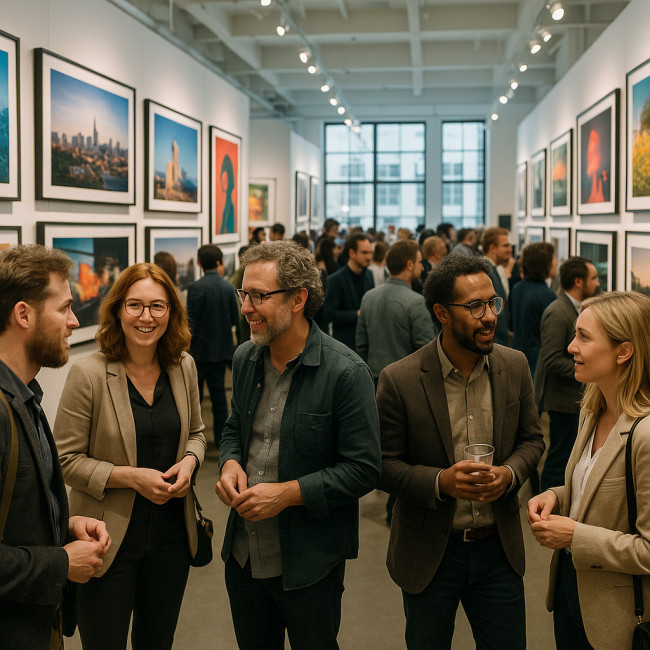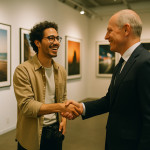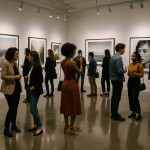How to network effectively at photo fairs without sounding salesy
Photo fairs gather gallery directors, agency buyers and fellow creatives in one buzzing hall. The opportunity is huge, yet many photographers leave with handfuls of business cards and zero real leads. This guide gives you practical, non-pushy tactics to turn brief fair encounters into partnerships, assignments and referrals.
Why photo fairs still matter in 2025

Even with remote portfolios and AI-driven scouting, face-to-face impressions remain a top hiring trigger for visual work. A recent industry survey shows 72 % of creative directors award projects to photographers they have met in person during the previous 12 months. Fairs compress months of outreach into a single weekend and add the emotional layer that screens can't convey.
- Instant feedback on style trends and rates.
- Access to decision-makers who normally hide behind assistants.
- Peer learning from live print critiques and gear demos.
Set clear networking goals before you arrive
Define your ideal contact persona
List three job titles you want to meet—example: “luxury hotel art buyer”, “senior photo editor”, “gallery coordinator”. Visualising the exact person keeps you from pitching randomly.
Research exhibitors and talks
Browse the event photographer directory on Artfolio and the fair's speaker list. Highlight booths matching your niche and note any shared connections on LinkedIn. Send a brief “Looking forward to your talk” message; it paves the way for a warmer in-person chat.
Craft a genuine introduction, not a pitch
The three-sentence framework
- Context: “I loved the series you curated on coastal conservation…”
- Connection: “…I recently completed a similar commission for a marine NGO.”
- Curiosity: “What did you find most challenging about building that show?”
This structure signals relevance, shared interest and inquisitiveness—no hard sell.
Body language counts
- Stand at a 45-degree angle to reduce confrontation vibe.
- Hold your portfolio at waist level, not chest level—open stance invites dialogue.
- Maintain eye contact for 3–5 seconds, then glance at their work to keep focus on them.
Listen more than you talk
Five high-value questions
- “Which visual trend are your clients asking for lately?”
- “How do you evaluate new photographers beyond the portfolio?”
- “What timeline pressures do you face on location shoots?”
- “Which skill gaps do you see in the market right now?”
- “How do you prefer photographers follow up after the fair?”
Write answers in a pocket notebook; typing on a phone can appear distracted.
Show your work without bragging
Choose the right format
| Format | Ideal use | Time to browse |
|---|---|---|
| Mini print deck (A6) | Quick stand-up chats | < 60 s |
| Tablet portfolio | Seated review corners | 2–3 min |
| QR code to curated online gallery | Busy corridors | Later, on their terms |
Limit displays to 12–15 images. Curated restraint beats a 100-image dump every time. For layout inspiration, review our guide on portfolio booth layout.
Tell a one-minute story
Pick one image, then narrate:
- Client problem.
- Your creative choice.
- Measurable outcome (e.g., 18 % higher ad click-through).
Story-driven sharing positions you as a problem-solver, not just an image maker.
Capture details and follow up like a pro
The 30-second capture ritual
After a fruitful chat, ask, “May I note your best email to send the promised links?” Write it, then jot one personal cue—“loves natural light portraiture.” This reference fuels personalised follow-ups.
24-hour email template
Subject: Great meeting at Paris Photo – marine series link
Hello [Name], thank you for the conversation about coastal projects yesterday. Here's the five-image set we discussed (low-res preview, 2 MB). I especially recalled your point on authentic storytelling.
Would love your feedback when time allows. If a future brief emerges around conservation themes, count me in.
Best, [You]
Common mistakes to avoid
- Handing out cards before confirming mutual interest.
- Dominating panels with self-promotion during Q&A.
- Ignoring peers; today's assistants are tomorrow's art directors.
- Skipping meal breaks—low energy makes you sound insincere.
Level-up opportunities during the fair
Book a 15-minute portfolio review; experts can flag gaps you missed. Read our deep dive on portfolio review sessions to prepare compelling leave-behinds.
Attend after-hours mixers. Soft lighting and fewer crowds ease longer conversations. For extra tactics, see the broader art-fair networking tactics guide.
Keep momentum post-fair
Block two half-days the week after the event to process contacts, edit tailored PDFs and schedule coffee meetings. Cross-reference dates with your photography event calendar so follow-ups include a proposed next meeting at the same or another fair.
Quiz: Are you networking or selling?
FAQ
- How many contacts should I aim for at one fair?
- Quality beats quantity. Ten meaningful conversations with clear next steps often generate more work than 50 superficial card swaps.
- Is it okay to show work on my phone?
- Yes, if your images are optimised and easily swipeable. Still carry a few physical prints—tactile impact lingers.
- What if I'm introverted?
- Prepare conversation starters and schedule one-to-one portfolio reviews where structured feedback replaces small talk.
- How soon is too soon to discuss rates?
- Wait until the prospect signals a concrete project or asks about budget. Early rate talk can feel transactional.
Ready to turn your next fair into a pipeline of paid briefs? Apply these tactics, refine after each event, and watch your creative network grow authentically.











